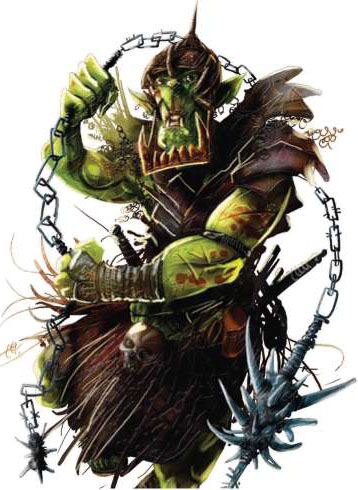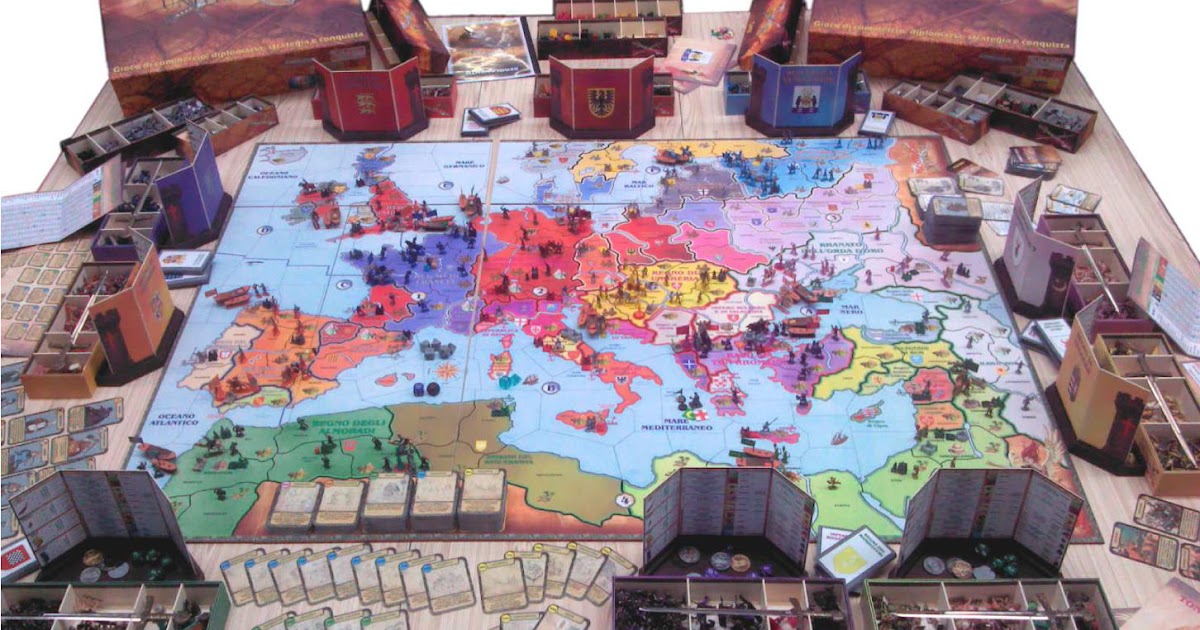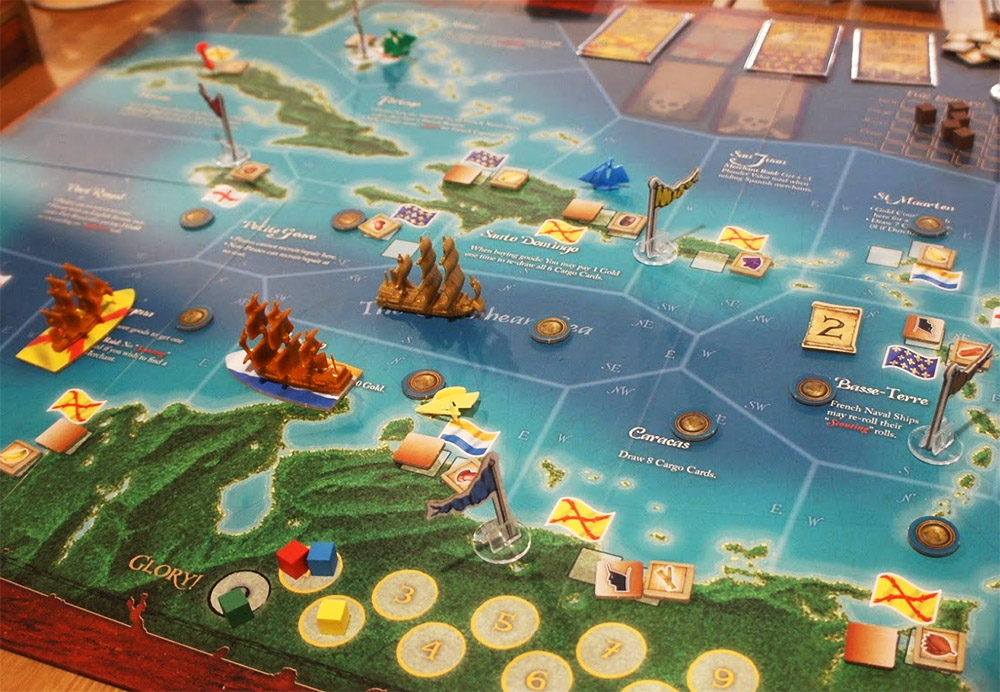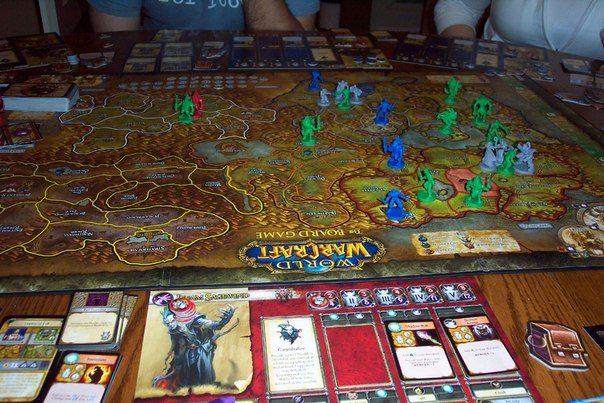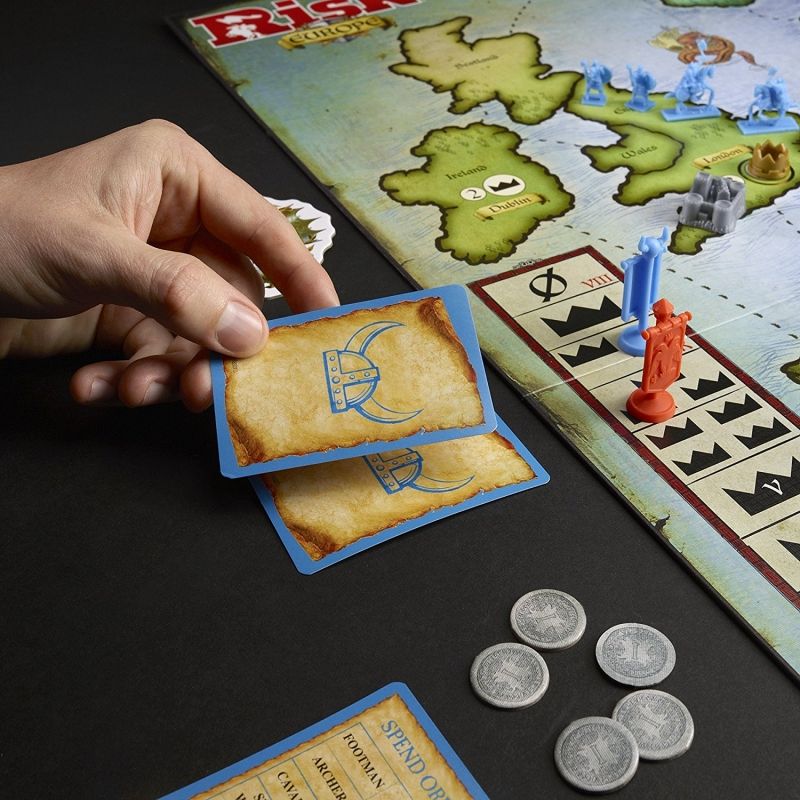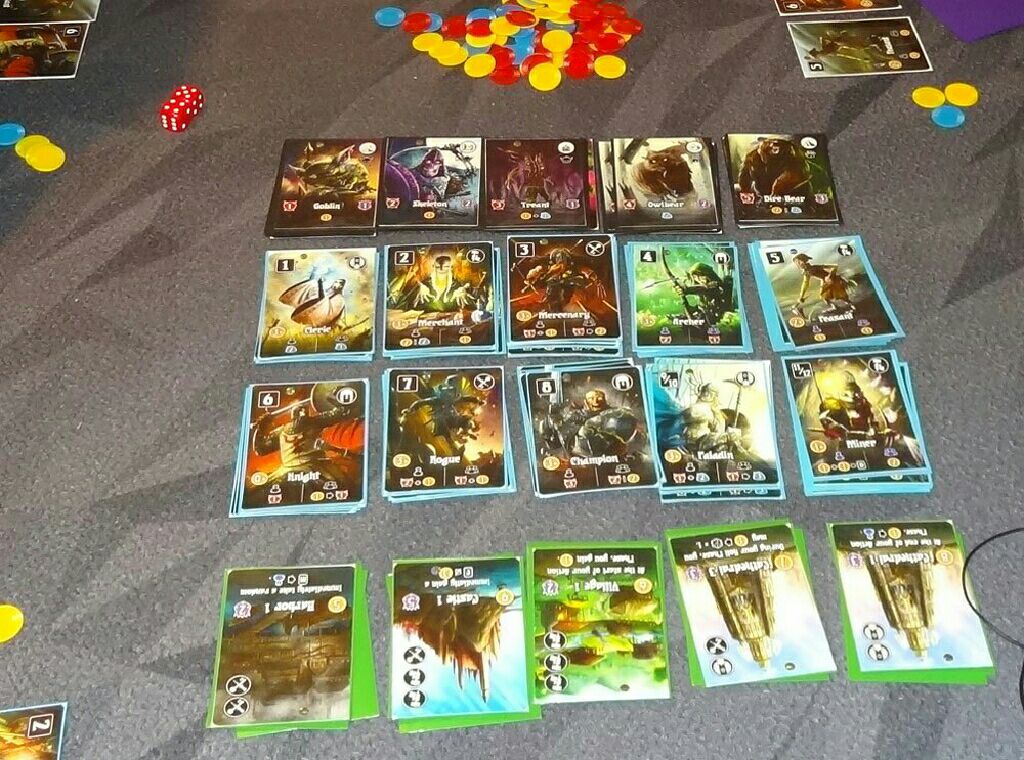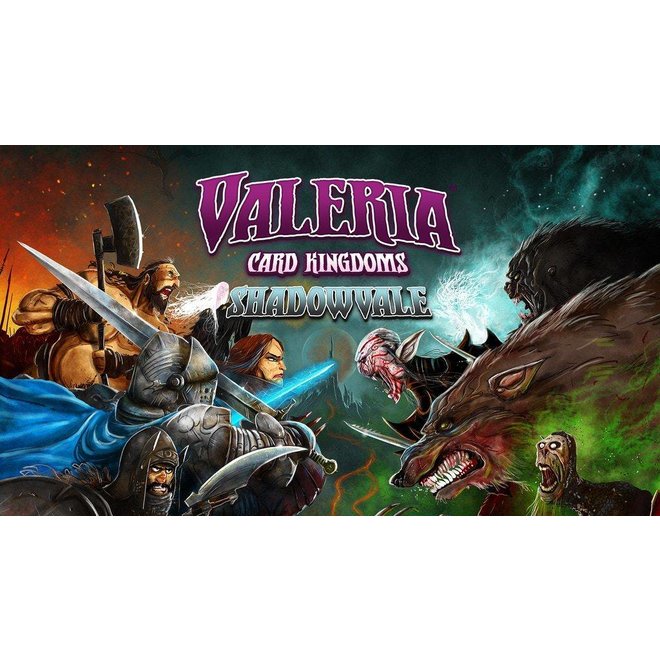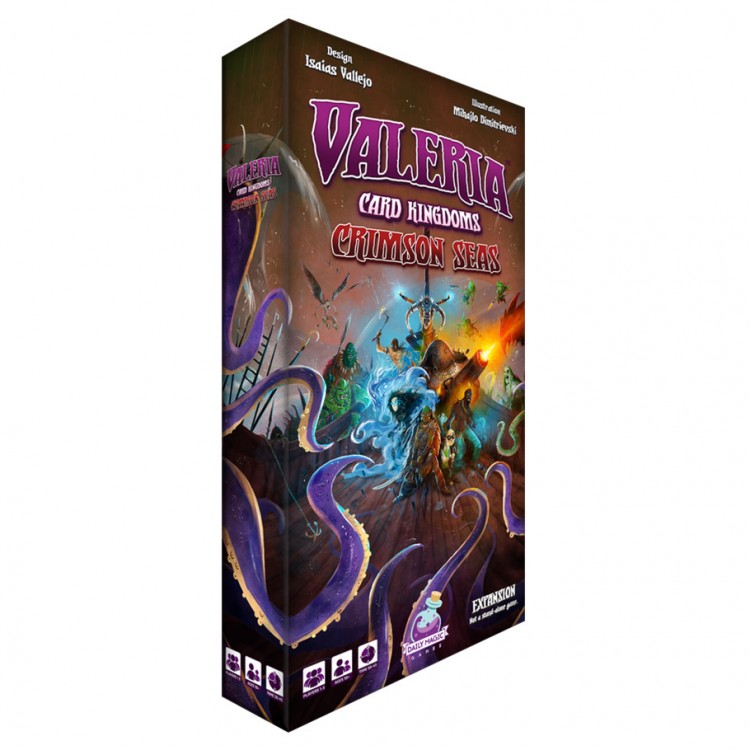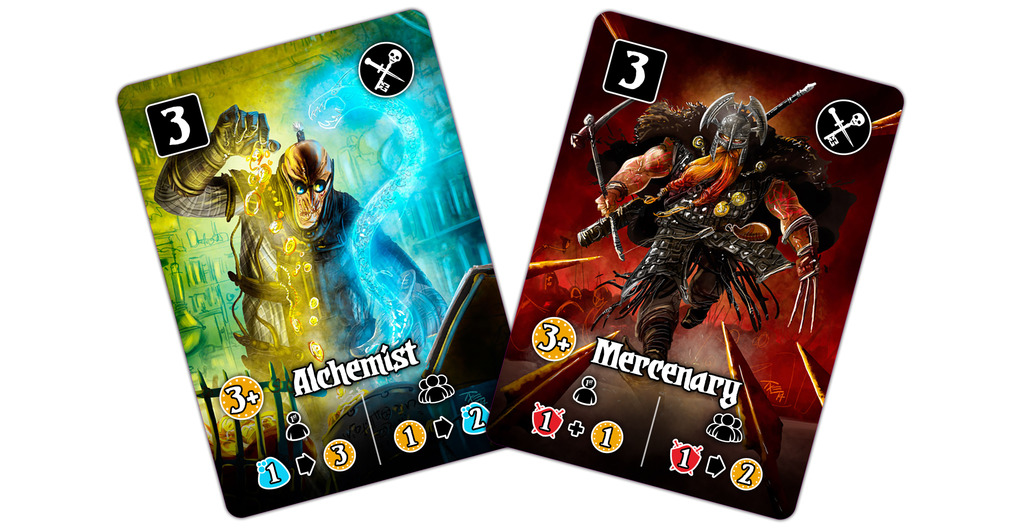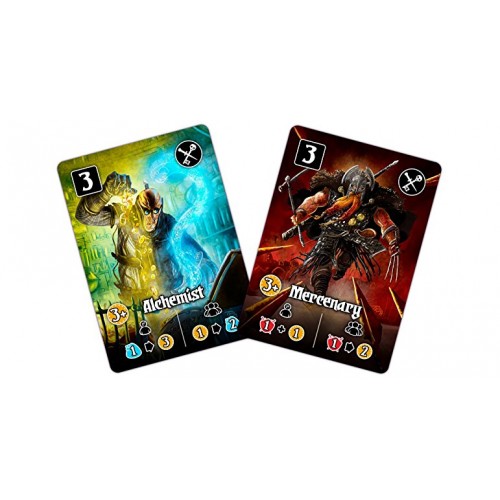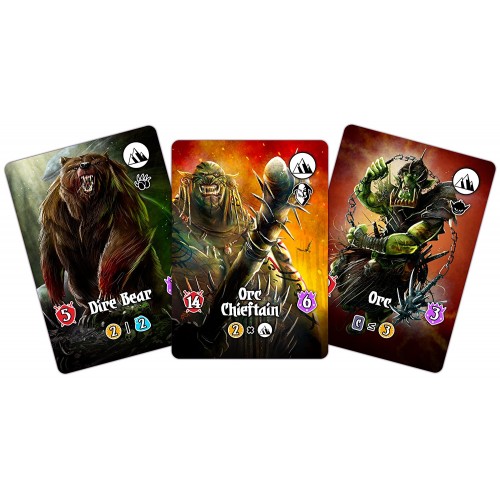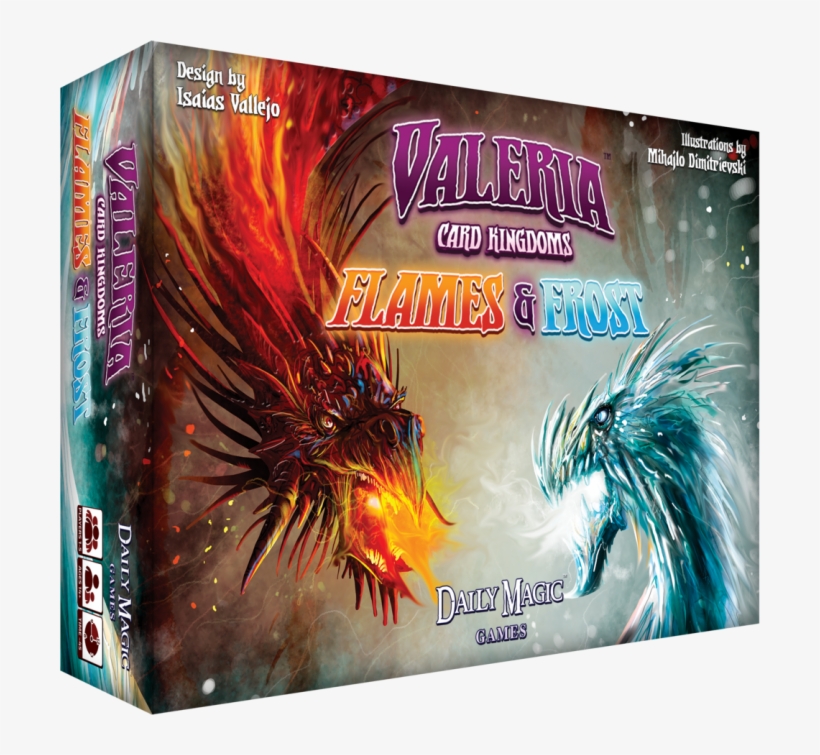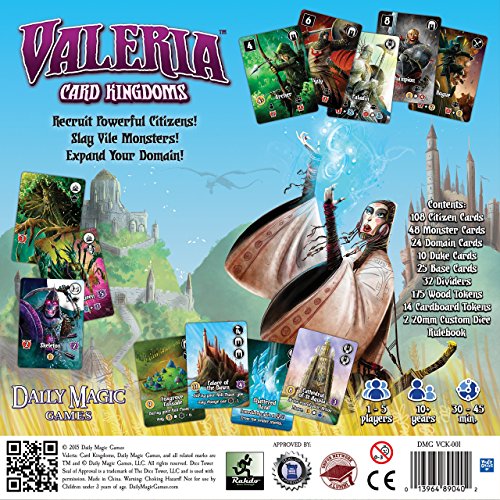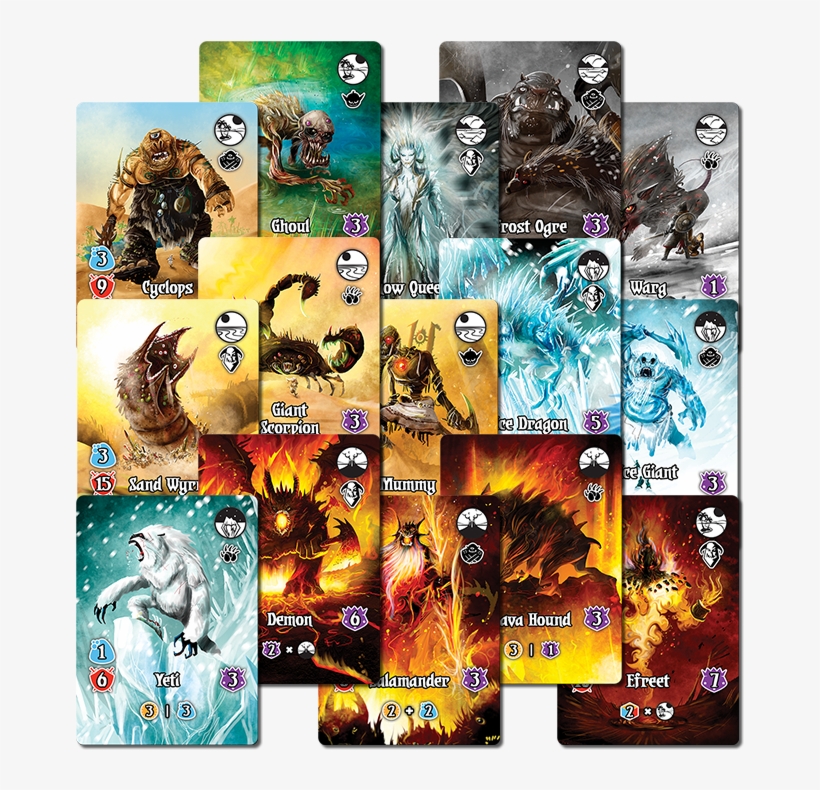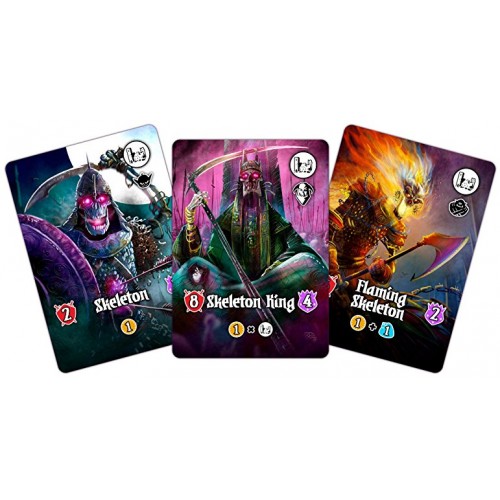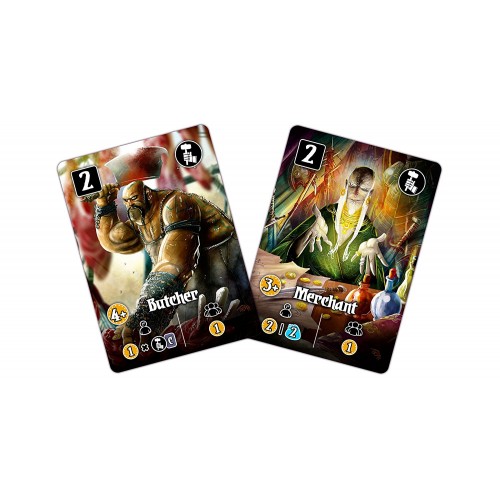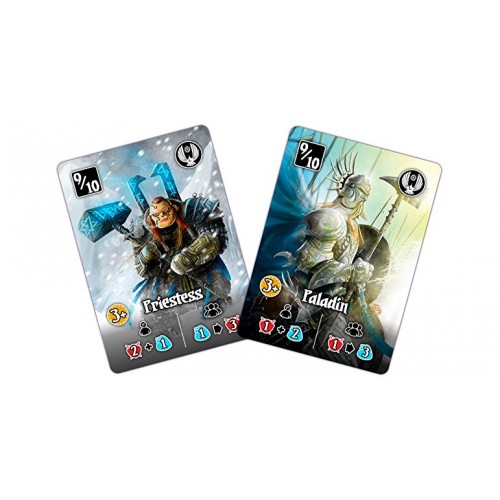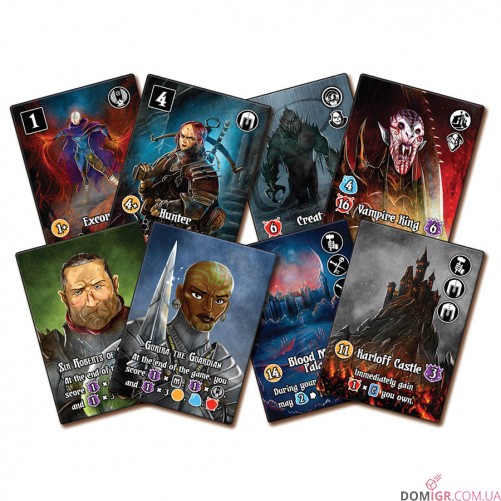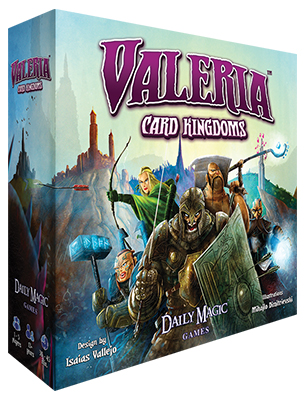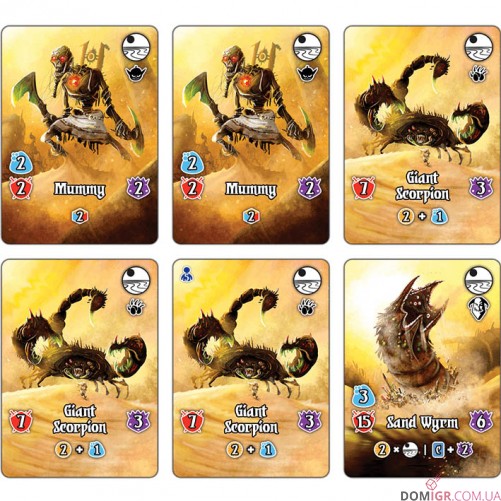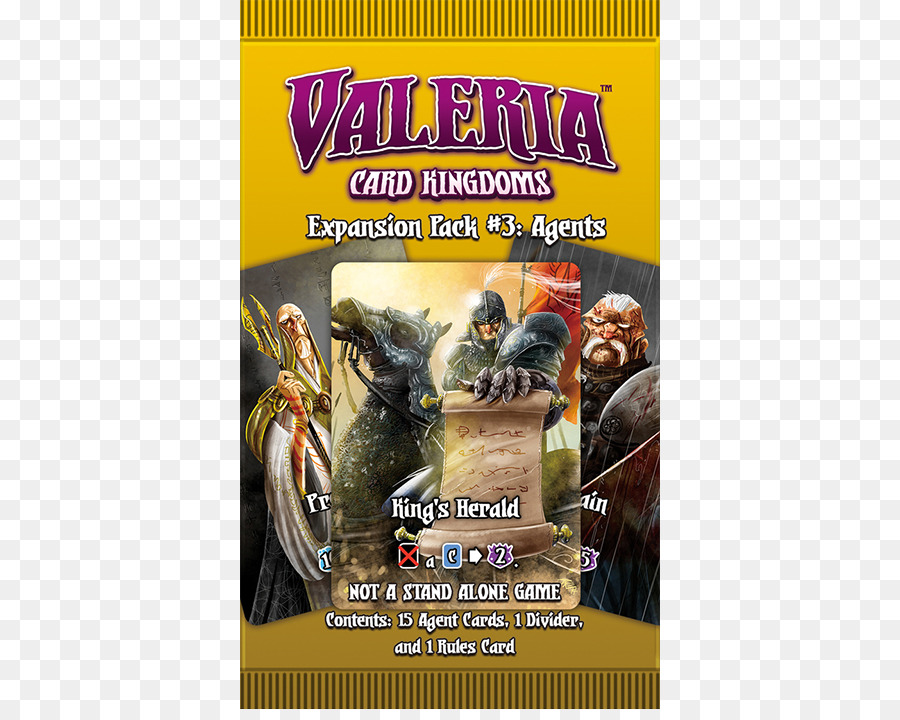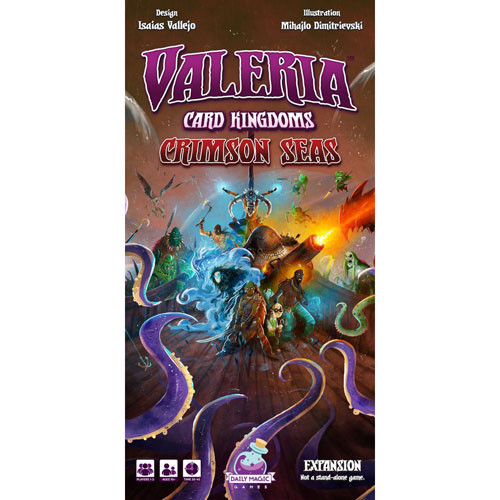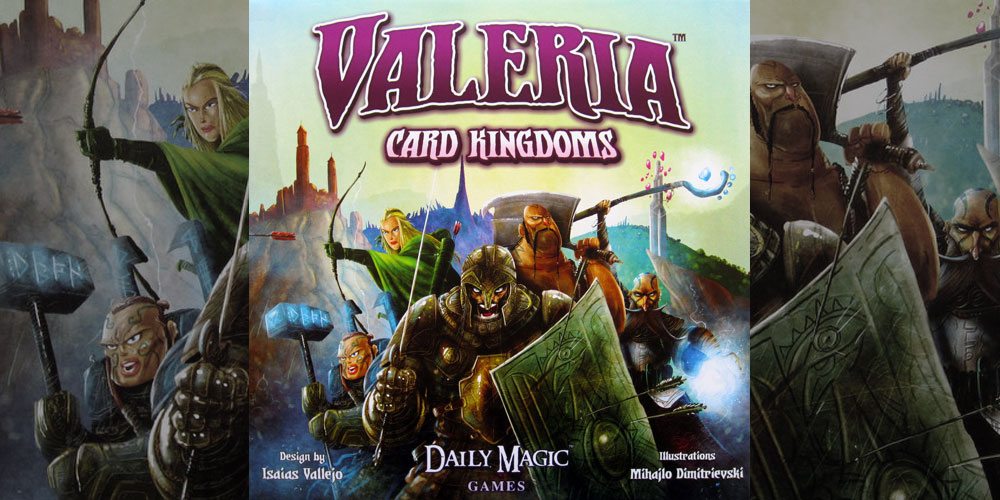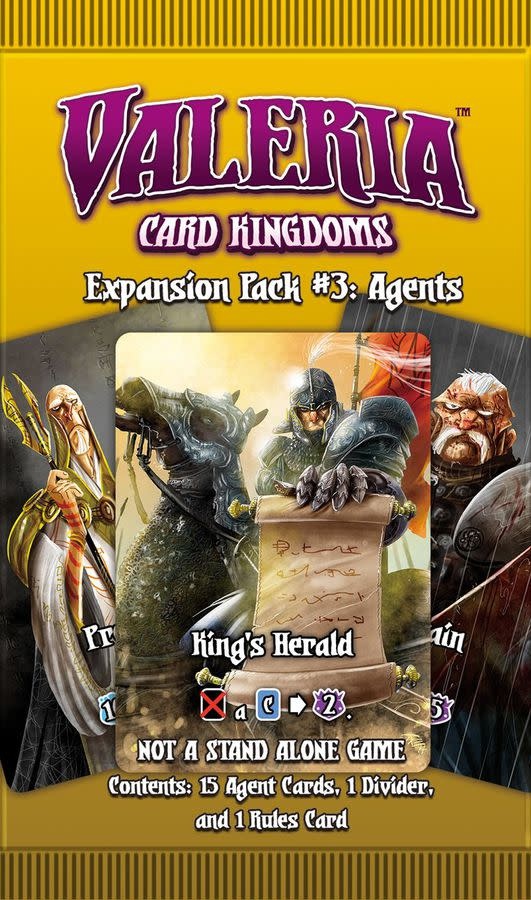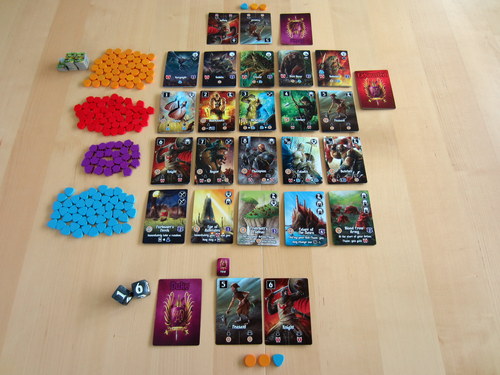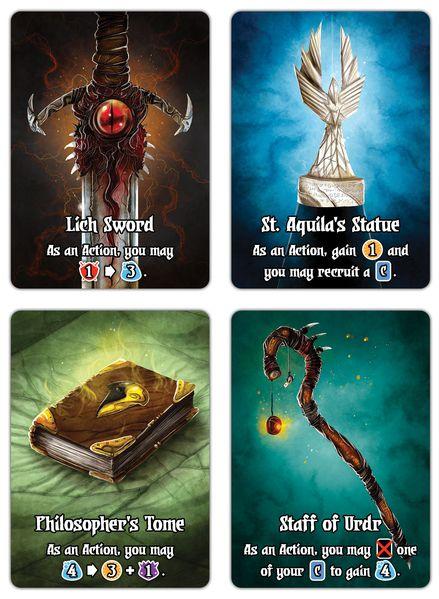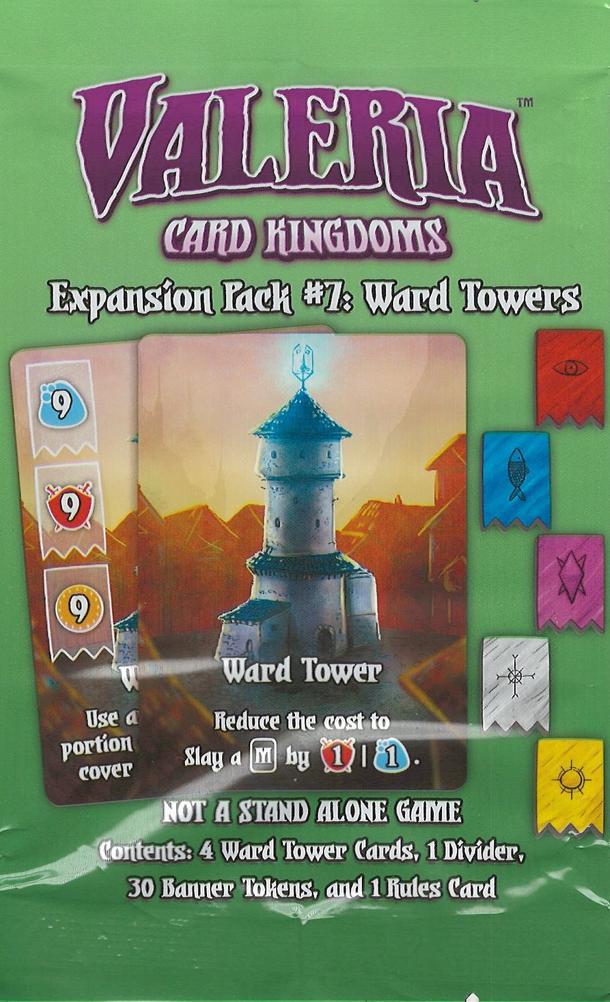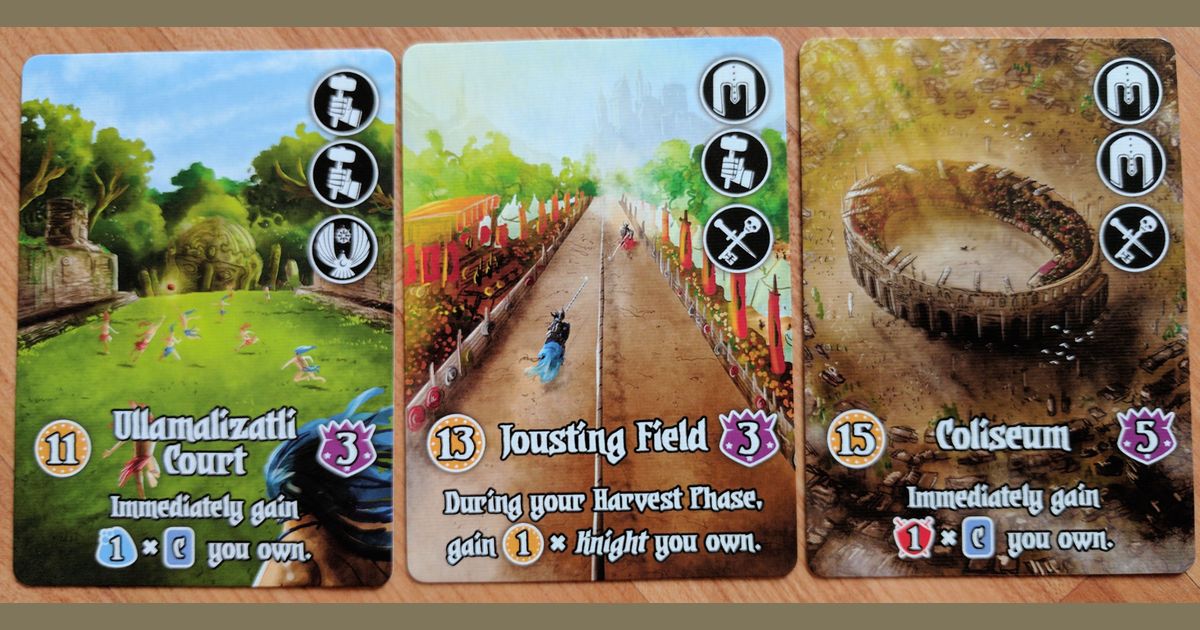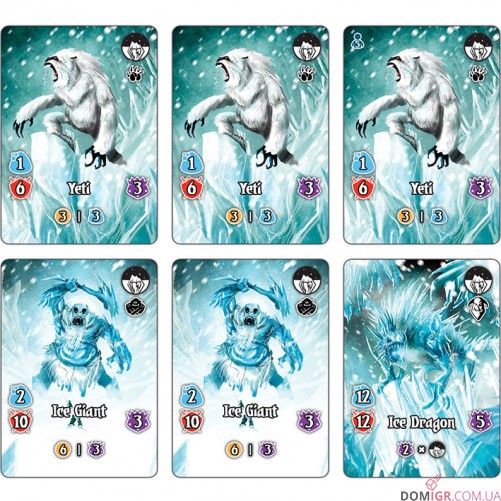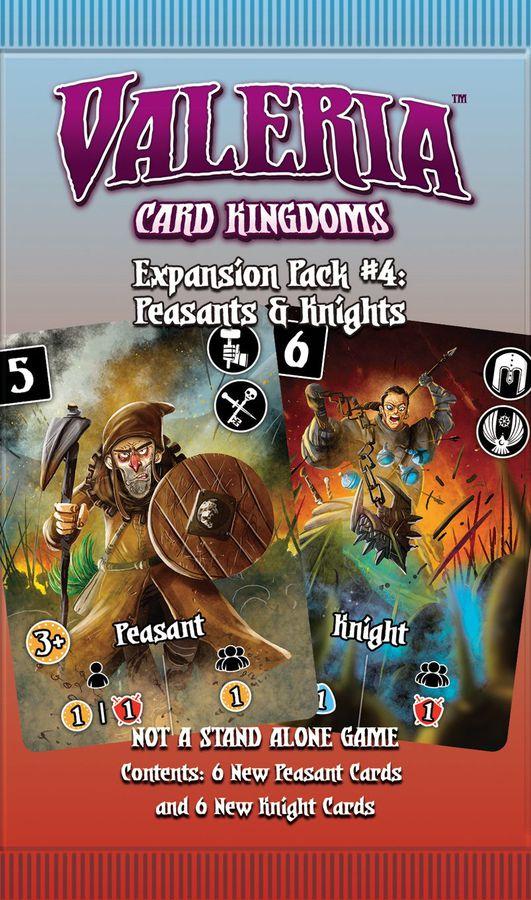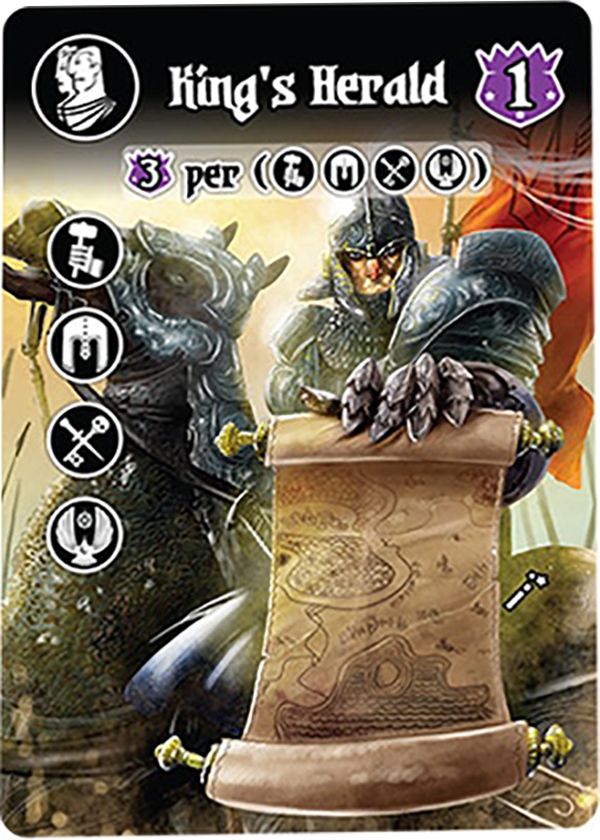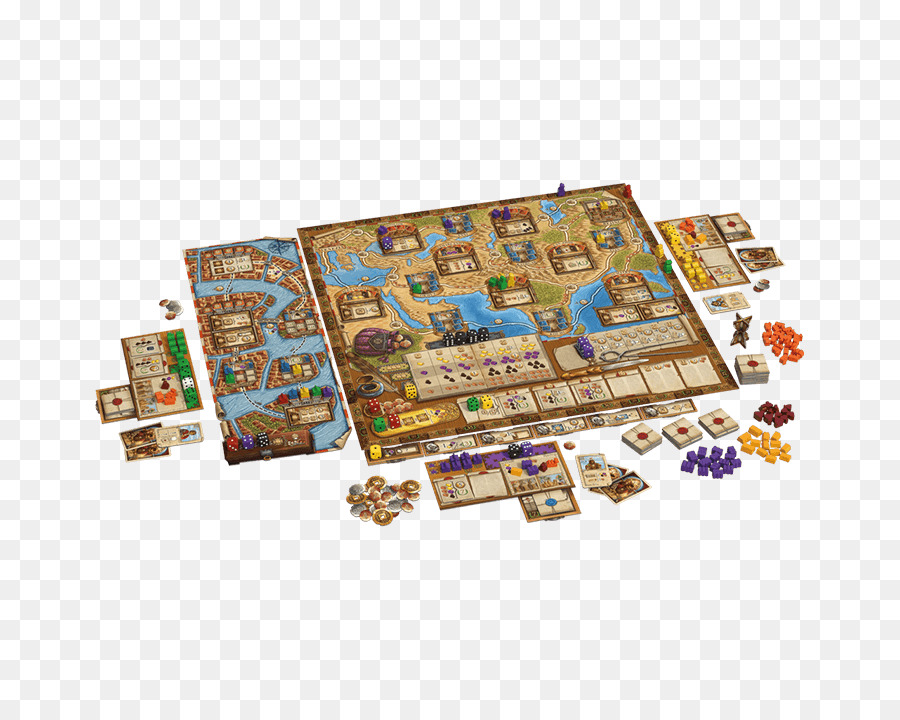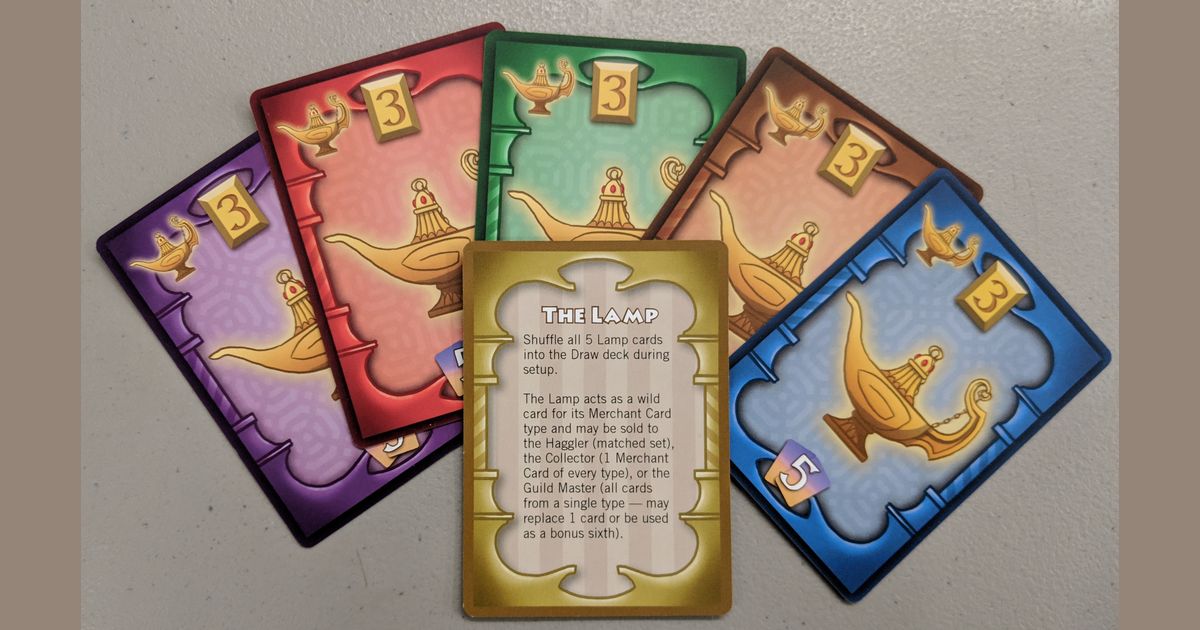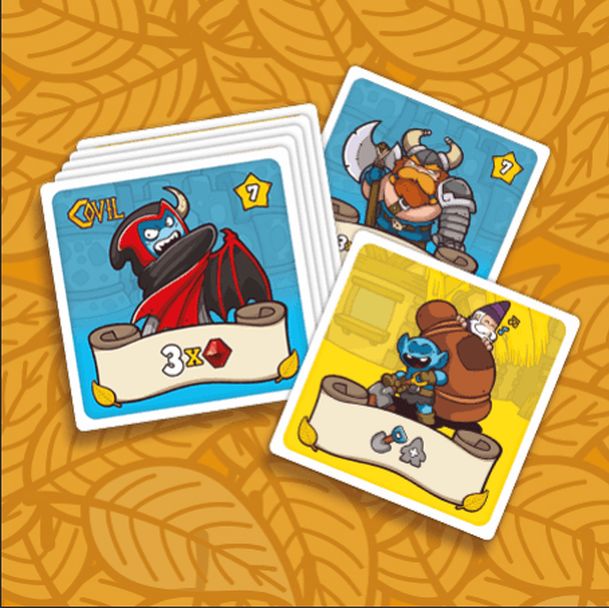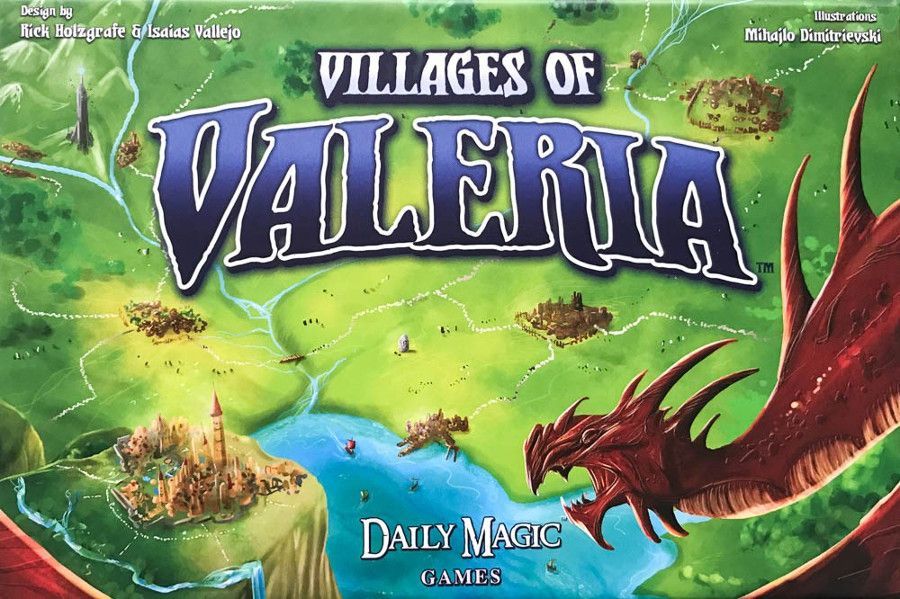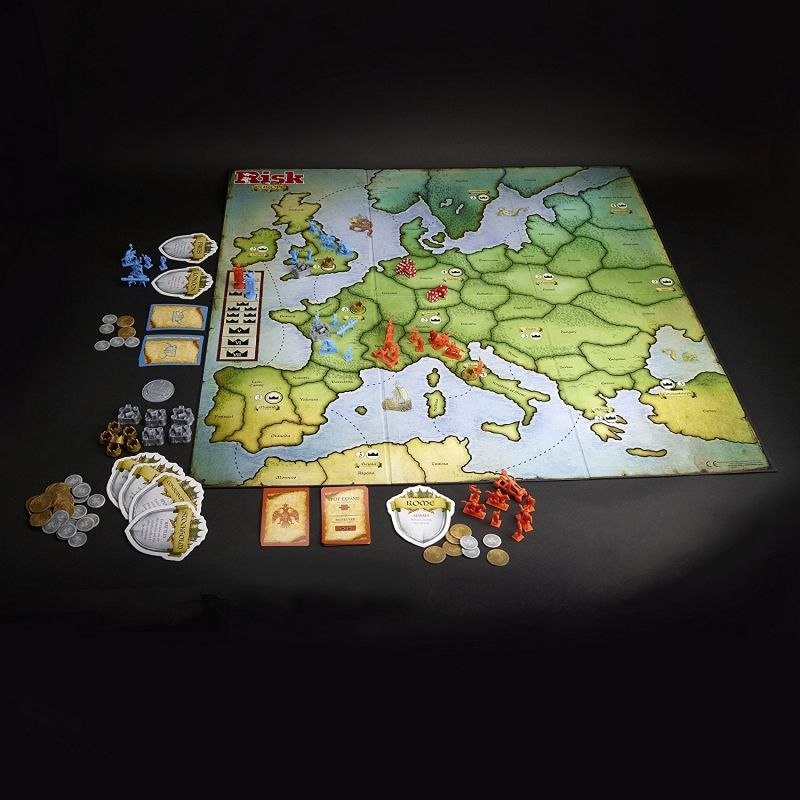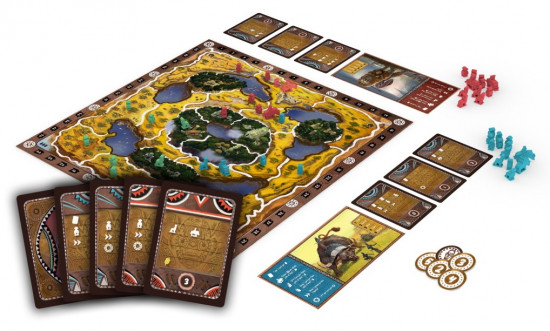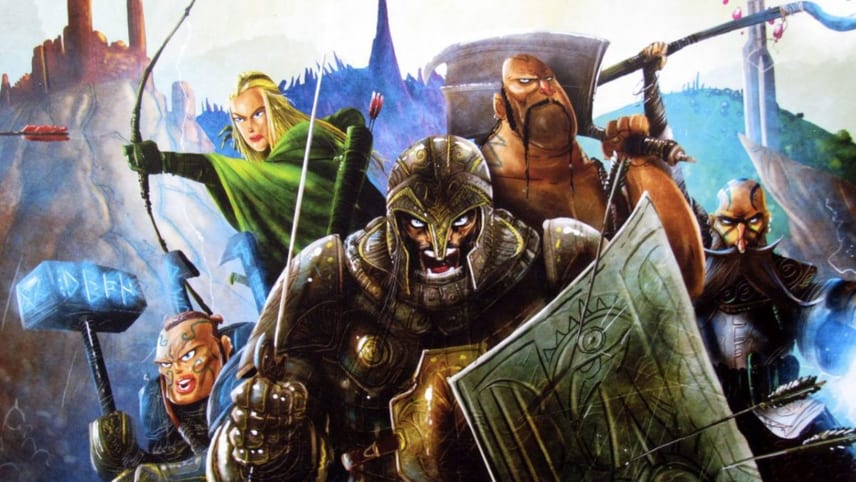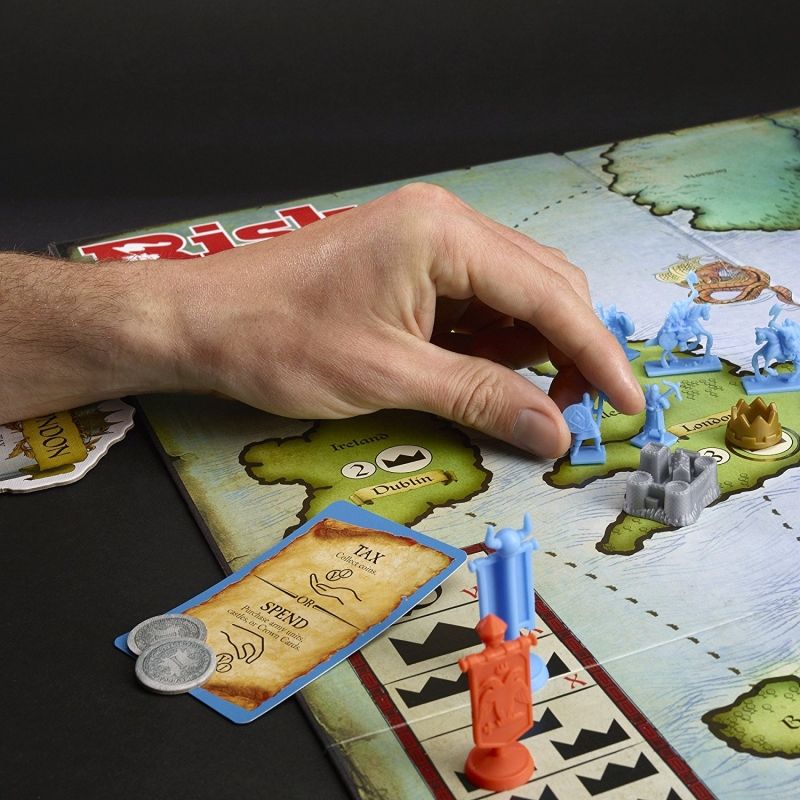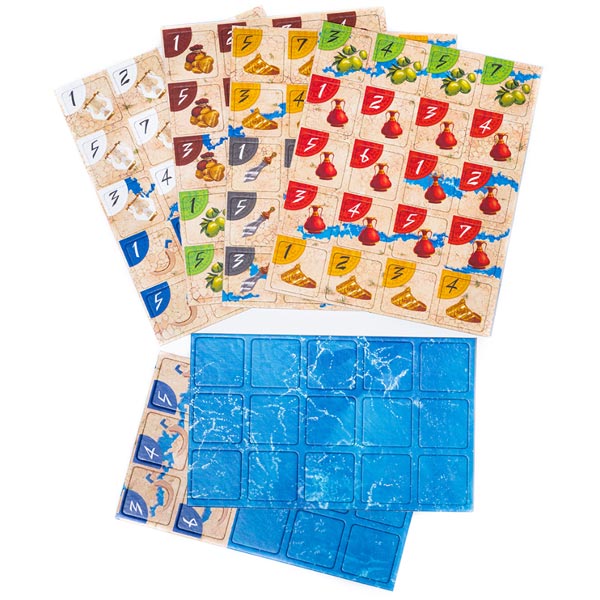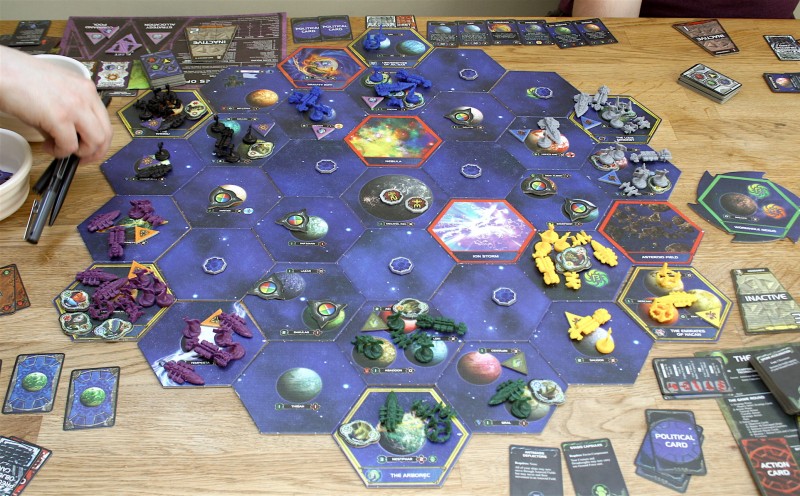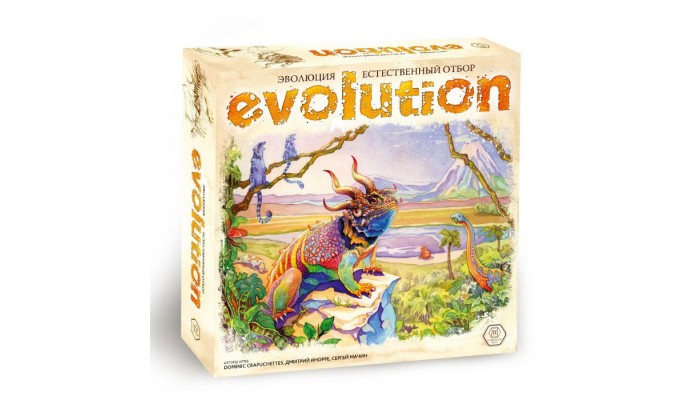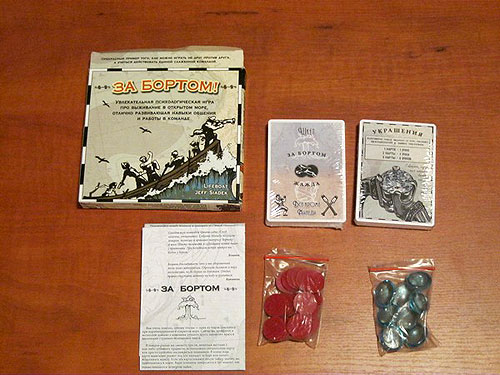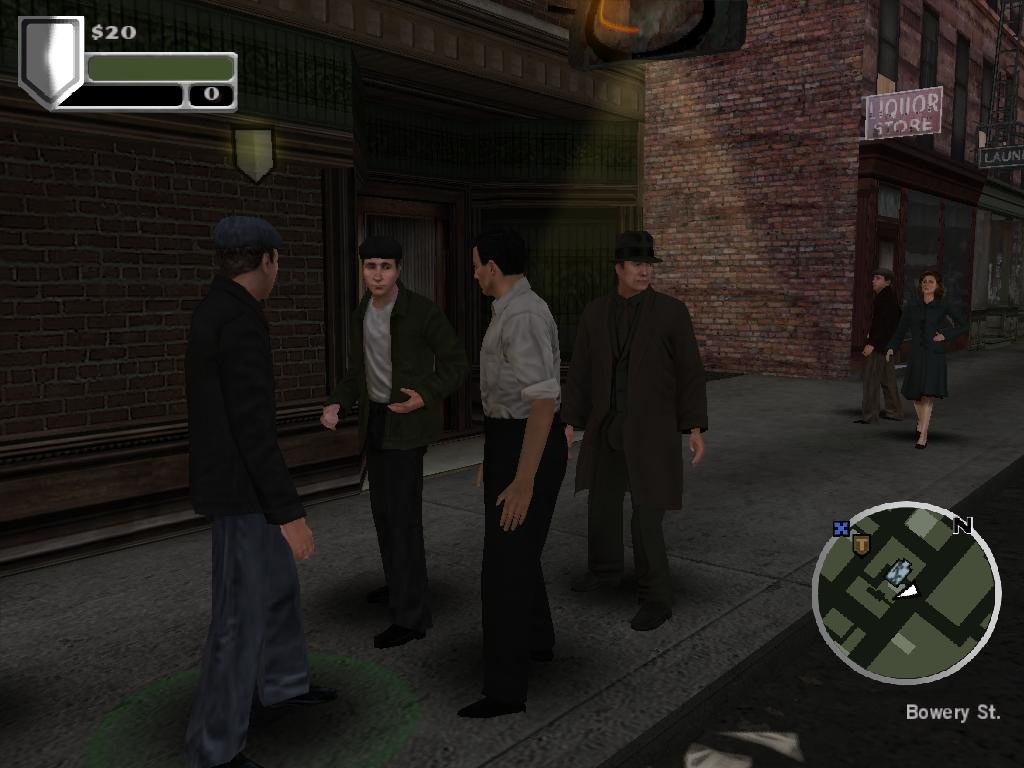Roll Phase
In this phase, the Active player rolls the 2 dice to determine the numbers that will activate Citizens in the Harvest Phase.
Each die value and the sum of both dice will activate the Citizens with matching Activation Numbers in each player’s tableau during the Harvest Phase.
Example: If you roll a 3 and 5, you will activate Citizen cards that have 3, 5, and 8 as their activation number.
Some Domain cards allow the Active player to change the die values during this phase. Before players Activate their Citizens, the Active player may decide to use the power of any number of the Domain cards they own. Each Domain card that changes a die may only be used one time per Roll Phase.
To end the Roll Phase, the Active player announces the results of the dice roll and play proceeds to the Harvest Phase.
Domain Cards
Domain cards represent the territory or buildings in Valeria that you need to acquire in order to expand your kingdom. Building Domains will help you attain powerful ongoing or one-time powers.
All Domain cards give you Victory Points at the end of the game. They may even be worth Victory Points depending on the Duke you selected.
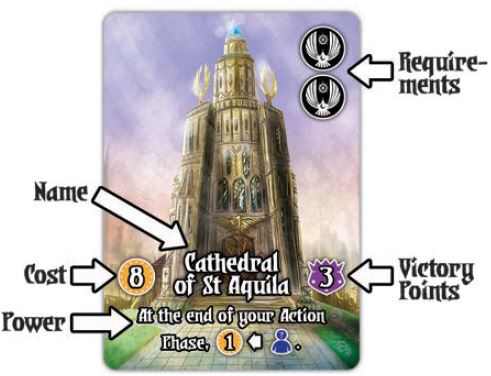
Domain Fiequlrements
To Build a Domain, you must first have Citizens in your tableau that match the Role icons shown in the upper right corner of the Domain card. If a particular Role icon is shown more than once, you need to have that number of matching Citizen cards.
Note: Your Starter Peasant and Starter Knight do not have Role icons so they do not count toward fulfilling a Domain card’s Role Requirement.
Domain Cost
After meeting the Role requirement of a Domain card, you must then pay the Gold cost in order to build that Domain.
Magic tokens may be used to augment your Gold tokens, but at least one Gold token must be spent.
Domain Powers
A special reward or power is described at the bottom of each Domain card. This benefit is granted to you for building that Domain. If a Domain card’s text breaks the rules written here, the Domain card supersedes these rules.
Some Domains grant an immediate reward that is received as soon as you build the Domain. Occasionally, these rewards will grant you an additional action as a reward. fulfilling the additional action is still a part of the Buy a Domain action and is not considered one of the two actions you may take in a turn.
Some Domains provide an ongoing power and describe the effect as well as when the effect activates. It is possible that two different powers can take effect at the same time. this happens, you choose in which order you would like to trigger the powers.
Victory Points
All Domain cards provide Victory Points that are scored at the end of the game. The Victory Point value is found on the middle-right side of the Domain card.
5-player Variant
The instructions below cover the rule changes for 5-player Valeria: Card Kingdoms. All other standard rules apply.
Setup
Each stack of Monster cards will contain 6 cards. Include the cards with
Each stack of Citizen cards will contain 6 cards.
Each stack of Domain cards will contain 4 cards, with 3 face-down cards and 1 face-up card on top of the stack.
Resting Player
After selecting the First Player, give the Rest Token to the person to the First Player’s right; that person is the Resting Player for the first round.
Each time the dice pass left to the next Active Player, the Rest Token passes to the left.
Harvest Phase
In this phase, players will acquire or trade Resources according to the Citizens they own that are activated by the Roll Phase. All players participate in the Harvest Phase.
Each Citizen card has 2 powers shown at the bottom of the card. When a Citizen is activated, both powers are activated, but a player only uses one power, according to whether they are the Active player or a non-Active player:
The left-side (on-turn) power under the icon only applies to the Active player.
The right-side (off-turn) power under the icon only applies to the non-Active player(s).
If you have more than 1 copy of a Citizen card, each of those Citizens are activated individually.
Example: If you have two Archers (activation number 4) in your tableau, a result of 4 will activate both of the Archers.
Rolling doubles will activate each matching card twice.
Example: If you have three Archers and the result is double Ts, then each Archer will activate for one 4 result and then each Archer will activate again for the other 4 result, for a total of six activations.
Resource tokens received or paid during the Harvest Phase are taken from or paid to the Bank unless the card says otherwise. The only Citizen that takes from another player is the Thief.
When the Thief is activated, they act first at the beginning of the Harvest Phase before other Citizens activate.
Example: You roll a 2 and 5 (which is also a 7) and own a Thief. You must activate your Thief io take someone’s Gold or Magic before other players activate their Peasants to take Gold from the off-turn power.
During the Harvest Phase, a player may use the power of the Citizens that are activated in any order they wish.
Example: You roll a 1 and 4 (which is also a 5). You are not the Active Player and you own a Monk (activation number 1) and a Peasant (activation number 5). You use the Peasant’s power to gain 1 Gold, then you immediately use the Monk’s power to return that 1 Gold to the Bank to gain 2 Magic.
If the dice roll did not activate any of a player’s Citizens, then that player may take any one Resource from the bank regardless of whether they are the Active player or not.
After completing the Harvest Phase, play proceeds to the Action Phase.
Citizen Cards
Citizen cards represent the people in Valeria that you can hire to help your kingdom prosper. Recruiting Citizens will help you gain and trade Resources throughout the game.
Additionally, they will help you meet the requirements needed to build Domains and may even give you Victory Points at the end of the game, depending on the Duke you select.
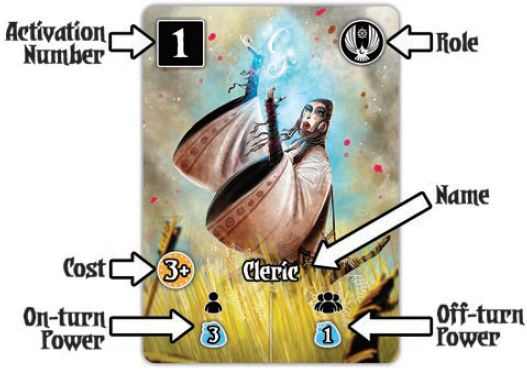
Citizen Names
Each Citizen has a name that can be found in the center of the card. These names are also considered the Citizen type when referring to the “+” symbol during the Recruit a Citizen Action.
Additionally, these names are referenced on some card powers in the game. When sorting Citizen stacks, each stack must only contain 1 Citizen name.
Activation Numbers
Your Citizen cards activate based on the Activation Number in the top left corner of each card. If there are two numbers, it means that the Citizen activates with either of the numbers shown.
Citizen Role Icons
Each Citizen card has a Role icon shown in the upper right corner of the card.

The Role icon provides a reference for several game functions:
Counts as one of the Role icons needed to match on a Domain card in order to use the Build a Domain Action.
Certain Citizen powers, Monster rewards, and Domain rewards reference specific Role icons.
If the Role icon overlaps a Citizen card type icon, then the power or reward only applies to Citizen cards with that icon.
Citizen Cost
To recruit a Citizen card from the Center Stacks, you pay an amount of Gold equal to the cost shown on the card (base cost) plus 1 Gold for each copy of that card you already have in your tableau.
The symbol on each Citizen Gold cost is there to remind players that Citizen prices increase as you get more of each Citizen with the same name.
Citizen Towers
There are two Harvest Phase powers on the bottom of each Citizen card. The left side with the icon is only used by the Active player and is also referred to as the on-turn power. The right side with the icon is only used by non-Active players and is also referred to as the off-turn power.
When a power references a Role icon, the icon is next to and under the Role icon to remind you that it only counts Citizen cards with that same Role icon in your tableau.
If a power references any Card Types, card names, or Citizen Roles, then it is referencing any cards in your tableau or Victory stack at that time.
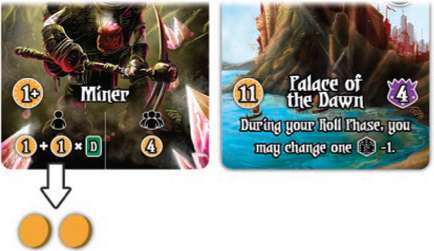
Example: You are the Active player and the sum of your dice roll is 12. The left-side harvest payout for the Miner in your tableau indicates that you gain 1 Gold + 1 Gold per Domain card in your tableau. You have previously purchased the Palace of the Dawn, so you gain 2 Gold.
Some powers may reference Citizen names, and you count any cards with the same name in your tableau.
Mixed Citizen Variant
The instructions below cover the rule changes for the Mixed Citizen Variant of Valeria: Card Kingdoms. All other standard rules apply.
Citizen Cards
When setting up the Citizen stacks, take all of the Citizen Types with the same Activation number and shuffle them together.
Deal out 4 Citizens for a 4-player game or 5 Citizens for a 5-player game face down and then deal 1 Citizen face up on top of the stack. Place the rest of the cards back in the box. Continue to do this for each Activation number.
Example: You take all of the Monk cards and all of the Cleric cards and shuffle them together. You are playing a 4-player game of Valeria: Card Kingdoms, so you deal out 4 face down and then 1 face up to form the Activation number “1” stack.
During the game, Citizens that are face down are not public knowledge and may not be revealed until the Citizen directly above it has been taken by a player.
Continue Reading
Setup
Cards are arranged by five columns to in a grid of four rows form the Center Stacks. Other stacks, tokens, and markers are placed around the Center Stacks after they have been set up. Remove any cards with the 5-player icon: .
Monster Cards
The top row consists of the Monster cards. Sort the Monsters into stacks by the area icon in the top right corner of each card.
Keeping the Monsters face-up, arrange the Monsters in each stack so that the Monster with the highest Strength is at the bottom, the lowest Strength is at the top, and the middle Strength is in between.

Position each Monster stack in the top row so that the leftmost stack has the lowest Strength number and the rightmost stack has the highest Strength number.
For your first game, we recommend that you play with the following Monster stacks, listed below to be positioned from left to right, with the individual Monsters arranged from top to bottom:
- Hills (3 Gohlin, 1 Goblin Mage, 1 Goblin lUng)
- Hains (2 Skeleton, 2 Flaming Skeleton, 1 Skeleton king)
- forest (2 Treant, 2 Bane Spiller, 1 Spider Queen)
- Valley (3 Owlbear, 1 Giant, 1 Troll)
- Mountains (2 Dire Bedr, 2 Ore Warrior, 1 Ore Chieftain)
Return any remaining Monster stacks to the box.
Citizen Cards
The two middle rows consist of the Citizen cards. Sort the Citizens into stacks by their name. For example, one stack of Monk cards, one stack of Cleric cards, etc.
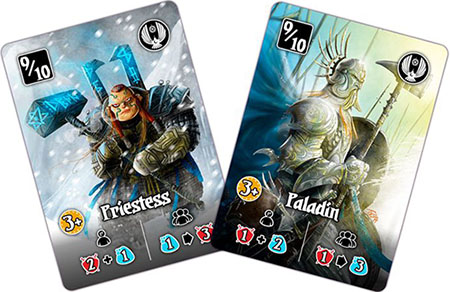
Choose one Citizen type per activation number (upper left corner of each Citizen card). Remove 1 card per stack and place it back in the box – there should be 5 cards per stack. Place the stacks face-up in sequential order in the middle two rows of the Center Stacks.
For your first game, we recommend that you play with the following Citizen types, positioned in sequential order from left to right and separated by row:
- Cleric, Merchant, Mercenary, Archer, Feasant
- Knight. Rogue, Champion, Btladin, Batcher
Return any unchosen Citizen stacks to the box.
Domain Cards
The bottom row consists of the Domain cards. Shuffle all of the Domains together. Deal 2 face-down cards to each position in the bottom row, then deal 1 face-up card to each position in the bottom row. Return the unused Domains to the box.
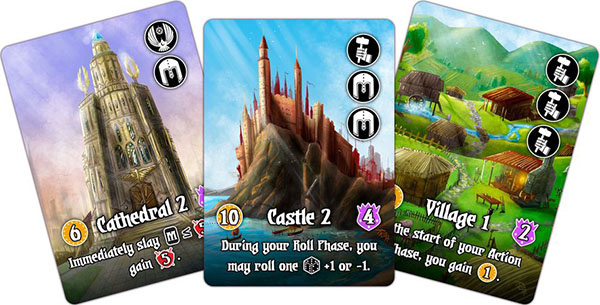
Starter and Reference Cards
Give each player 1 Starter Peasant card, 1 Starter Knight card, and 1 Reference card. These cards will form a player’s initial kingdom or tableau. Return any unused Starter and Reference cards to the box.

Starting Resources
Give each player 2 Gold tokens and 1 Magic token. Place the remaining tokens within easy reach of all players to create the Bank.
Players will take Resources from the Bank during the game unless otherwise stated. Some cards give players Victory tokens during certain conditions; these are also taken from the Bank unless otherwise stated.
Duke Cards
Shuffle all of the Duke cards together, then deal 2 Dukes to each player. Each player selects 1 Duke for this game and returns the unchosen Duke to the box. Each player keeps their Duke secret from the other players until the end of the game.
Active Player
Randomly select the first player. The selected player will be the first Active player in the game. Give them the First Player token and the dice.
You are now ready to play the game.
End of the Game
The end-game conditions are met at the end of the Active Player’s turn if:
- All of the Monsters have been slain, or
- All of the Domains have been built, or
- The number of Exhausted stacks is equal to twice the number of players.
Scoring
When the game is over, your score is the sum of the:
- Total Victory Mints on all of your slain Monsters.
- Total Victory Mints on all of your built Domains.
- Total Victory Mint tokens in your possession.
- Total Victory Mints scored from your Duke.
Note: If your Duke scores on Citizen Role icons, be sure to include the Citizen Role icons found on your Citizens and your Domains.
The player with most Victory Points wins the game.
In the event of a tie, the tied player who has the fewest cards in their tableau wins the game.
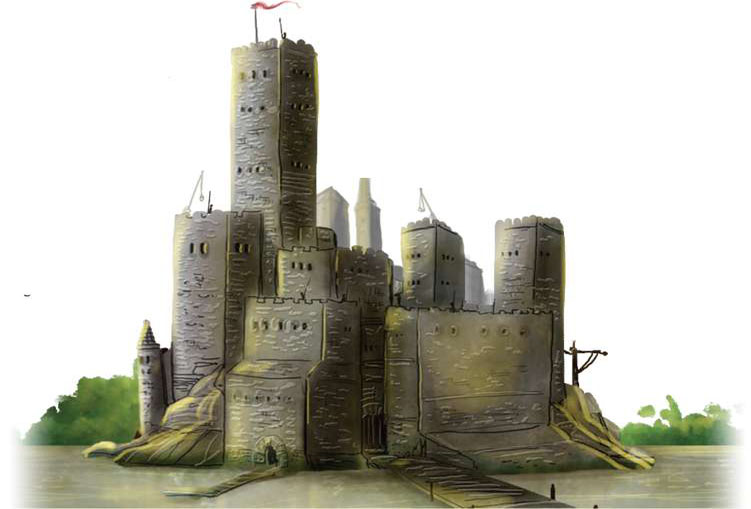
Recommended Starting Setups
The following are a list of recommended starting setups that focus on certain aspects of the game.
Glittering Gold
Monsters: Hills, Ruins, Forest, Swamp, and Caverns.
Citizens: Monk, Merchant, Alchemist, Archer, Rogue, Champion, Paladin, and Butcher.
Remove these Domains from the game: Forgotten Sorrows, The Violet Thorn, Colden Obelisk of Nae, and Monolith of Ostendaar.
Mastery Over Magic
Monsters: Barrens, Ruins, Forest, Valley, and Mountains.
Citizens: Cleric, Merchant, Alchemist, Wizard, Thief, Champion, Paladin, and Butcher.
Remove these Domains from the game: Foxgrove Palisade, Eye of Asteraten, nd Gargan’s Embrace.
Monster Blood
Monsters: Barrens, Ruins, Forest, Swamp, and Mountains.
Citizens: Cleric, Blacksmith, Mercenary, Archer, Rogue, Warlord, Priestess, and Miner.
Remove these Domains from the game: Forgotten Sorrows, Nest of the Weaver Witch, Cathedral of St. Aquila, and Cutthroat’s Truce.
Continue Reading
Action Phase
In this phase, the Active player takes 2 Actions from the following:
- Slag a Monster
- Recruit a Citizen
- Gain a Resource
- Build a Domain
The same action may be taken twice.
If a stack in the Center Stacks is ever Exhausted as a result of an action taken by a player, the player first finishes the Action and then adds an Exhausted card from the Exhausted stack above the Monsters to the empty position.
A player must take 2 Actions and may not move on to the End Phase until both Actions are completed. After the Active player has taken their 2 Actions, play proceeds to the End Phase.
Slay a Monster
This action allows a player to take a Monster from the top of a stack and add it to their Victory stack. To Slay a Monster:
Select a Monster that is on top of a stack.
Pay the Resources equal to the Strength and Magic cost on the Monster card. Magic can be used to augment Strength, but you must spend at least one Strength token.
Some Monster cards cost both Strength and Magic to slay. If so, the Magic cost is in addition to any Magic tokens you might be using to augment your Strength tokens.
Take the Monster and place it face-up in your tableau in your Victory stack. This is public information for the rest of the game.
Take the Rewards at the bottom of the Monster card from the Bank and/or Center Stacks.
Example: The Treant is at the top of the Forest Monster stack. It has a Strength of 3.
You spend 1 Strength and 2 Magic tokens to slay the Treant and add the card to your Victory stack. You then take 1 Gold and 1 Magic as a reward from the Bank.
Recruit a Citizen
This action allows a player to take a Citizen from the top of a stack and add it to their tableau. In order to Recruit a Citizen:
Select a Citizen that is on top of a stack.
Pay the Resources equal to the Gold cost (base cost) on the Citizen card plus an additional 1 Gold for each copy of the same Citizen you have in your tableau.
Magic can be used to augment Gold, but you must spend at least one Gold token.
Take the Citizen and place it face-up in your tableau. A Citizen card does not activate on the turn it is recruited.

Example: The cost to recruit a Peasant is 2+. Since you already have your Starter Peasant, the cost for a second Peasant would be 3 Gold (2 for the cost of the Peasant plus 1 because you already own a Peasant).
You spend 1 Gold and 2 Magic tokens to recruit the Peasant and add it to your tableau.
Build a Domain
This action allows a player to take a Domain from the top of a stack and add it to their tableau. In order to Build a Domain:
Select a Domain that is on top of a stack. In order to build a Domain, the Citizens in your tableau must have Citizen Role icons that match those on the Domain card
If the Domain card shows multiples of a Citizen Role icon, then you must have an equal number of matching Citizens in your tableau.
Pay the Resources equal to the Gold cost on the Domain. Magic can be used to augment Gold, but you must spend at least one Gold token.
Take the Domain and place it face-up in your tableau. This is public information for the rest of the game.
Take the Rewards at the bottom of the Domain card. Some Domains give you an immediate and one-time reward. Some Domains have an ongoing benefit and activate as stated on the card.
Reveal the next Domain by flipping it over if there is still a Domain card in the stack.

Example: The Palace of the Dawn Domain shows 1 Worker and 2 Soldier Citizen Role icons. You have a Peasant (which has a Worker Role icon) and 2 Archers (which each have a Soldier Role icon), so you meet the Citizen Role requirement.
You pay 11 Gold and take the Domain and place it face-up in your tableau. For the rest of the game, you may use its ongoing benefit.
If ever there is a conflict between the rules in this rulebook and the power on a Domain, the Domain supersedes these rules and you should follow the text on the card.
Monster Cards
Monster cards represent the vile monsters that threaten the kingdoms in Valeria. Slaying Monsters will gain you immediate rewards and give you Victory Points at the end of the game.

Monster Areas
Monsters are separated into eight Monster Areas.

Each Monster card shows an Area icon in the upper right corner indicating which stack the Monster belongs in. When sorting Monster stacks, each stack must contain the same Area icon.
Boss Monsters in the game will give rewards based on how many Monsters a player has slain from the same Area.
Monster Types
There are four Monster Types in the base game. Each Monster has a Monster Type icon below the Area icon.

These icons will become more important in future expansions, but for now, only the Boss and Titan icons are referenced in the base game. These references are found on Duke cards.
Monster Strength and Magic
All Monsters have a Strength value in the middle of the left side of the card. Some Monsters have a Magic value above their Strength value.
Each Monster Area has Monsters with 3 different Strength values. When sorting Monsters in stacks, the Monsters with the highest Strength go on the bottom, the weakest on top, and the other(s) in between.
The Magic value is ignored in this sorting process.
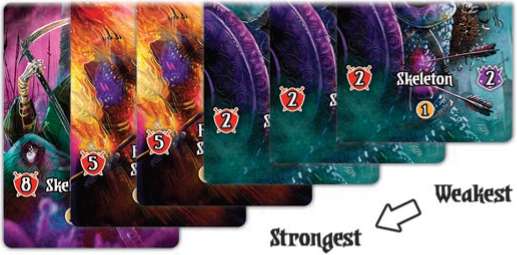
Example: When sorting the Ruins for a 5-player game, from bottom to top, place the Skeleton King, 2 Flaming Skeletons, and then 3 Skeletons.
To slay a Monster card at the top of any stack, you must spend Strength equal to the Strength value shown in the red shield icon on the left side of the Monster card.
Magic tokens may be used to augment your Strength tokens, but at least one Strength token must be spent.
Some Monster cards cost both Strength and Magic to slay. If so, the noted Magic cost is in addition to any Magic tokens you might be using to augment your Strength tokens.
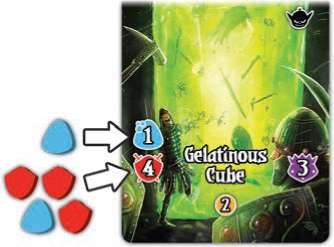
Example: The Gelatinous Cube is at the top of the Swamp stack and it has a 1 Magic and 4 Strength as its attributes. You spend 3 Strength tokens and 2 Magic tokens to slay the Gelatinous Cube.
Place all slain Monster cards face-up in a Victory stack in your tableau.
Monster Rewards
At the bottom of each Monster card is a reward that you receive immediately when you slay the Monster. Some Monsters require the player to choose a reward from available options shown on the card.
Some Monsters reward a player with a free Citizen card of up to a certain value. When you take a Citizen card in this way, ignore the ‘+’ symbol on the Gold cost for the Citizen and go by the base cost when acquiring a Citizen this way.
Some Monsters reward Victory Points, which should be taken immediately after slaying the Monster. If you are receiving Victory Points based on Monster Area icons, slain Monsters with the same Monster Area icon are counted.
Example: You slay the Spider Queen which gives you an option to either take 2 Gold for every Forest Monster you’ve slain or to take any Citizen from the Center Stacks and 1 Victory Point.
You have only slain the Spider Queen from the Forest area which would only give you 2 Gold, so you decide to take the latter reward and take an Archer from the Center Stacks and 1 Victory Point token from the Bank.
Victory Points
All Monsters reward the player with Victory Points at the end of the game. The Victory Point value is found in the middle of the right side of the Monster card.
